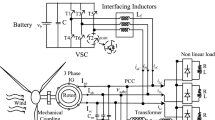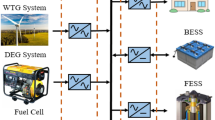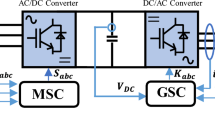Abstract
In the present work, a two-area thermal-hybrid interconnected power system, consisting of a thermal unit in one area and a hybrid wind-diesel unit in other area is considered. Capacitive energy storage (CES) and CES with static synchronous series compensator (SSSC) are connected to the studied two-area model to compensate for varying load demand, intermittent output power and area frequency oscillation. A novel quasi-opposition harmony search (QOHS) algorithm is proposed and applied to tune the various tunable parameters of the studied power system model. Simulation study reveals that inclusion of CES unit in both the areas yields superb damping performance for frequency and tie-line power deviation. From the simulation results it is further revealed that inclusion of SSSC is not viable from both technical as well as economical point of view as no considerable improvement in transient performance is noted with its inclusion in the tie-line of the studied power system model. The results presented in this paper demonstrate the potential of the proposed QOHS algorithm and show its effectiveness and robustness for solving frequency and power drift problems of the studied power systems. Binary coded genetic algorithm is taken for sake of comparison.











Similar content being viewed by others
References
B.R. Bagen, Evaluation of different operating strategies in small stand-alone power systems. IEEE Trans. Energy Convers. 20(3), 654–660 (2005)
A.N. Arthur, D. Lrrtle, Reliability and Distributed Generation, White Paper (1999)
S.C. Tripathy, K.P. Juengst, Sampled data automatic generation control with superconducting magnetic energy storage in power systems. IEEE Trans. Energy Convers. 12(2), 187–192 (1997)
S. Banerjee, J.K. Chatterjee, S.C. Tripathy, Application of magnetic energy storage unit as load frequency stabilizer. IEEE Trans. Energy Convers. 5(1), 46–51 (1990)
H.J. Kunisch, K.G. Kramer, H. Dominik, Battery energy storage another option for load-frequency-control and instantaneous reserve. IEEE Trans. Energy Convers. 1(3), 41–46 (1986)
H.J. Boenig, J.F. Hauer, Commissioning tests of the bonneville power administration 30 MJ superconducting magnetic energy storage unit. IEEE Trans. Power App. Syst. 104(2), 302–312 (1985)
N.G. Hingorani, L. Gyugyi, Understanding FACTS, Concepts and Technology of Flexible AC Transmission System (IEEE Press, New York, 2000)
L. Gyugyi, C.D. Schauder, K.K. Sen, Static synchronous series compensator: a solid-state approach to the series compensation of transmission lines. IEEE Trans. Power Deliv. 12(1), 406–417 (1997)
Z.W. Geem, J.H. Kim, G.V. Loganathan, A new heuristic optimization algorithm: harmony search. Simulations 76(2), 60–68 (2001)
Z.W. Geem, Recent Advances in Harmony Search (Springer, New York, 2010)
M. Mahdavi, M. Fesanghary, E. Damangir, An improved harmony search algorithm for solving optimization problems. Appl. Math. Comput. 188, 1567–1579 (2007)
M.G.H. Omran, M. Mahdavi, Global-best harmony search. Appl. Math. Comput. 198, 643–656 (2008)
Q.K. Pan, P.N. Suganthan, M.F. Tasgetiren, J.J. Liang, A self-adaptive global best harmony search algorithm for continuous optimization problems. Appl. Math. Comput. 216, 830–848 (2010)
A. Banerjee, V. Mukherjee, S.P. Ghoshal, An opposition-based harmony search algorithm for engineering optimization problems. Ain Shams Eng. J. 5(1), 85–101 (2014)
V. Mukherjee, S.P. Ghoshal, Application of capacitive energy storage for transient performance improvement of power system. Elect. Power Syst. Res. 79(3), 282–294 (2009)
M.S. Castro, H.M. Ayres, V.F. Costa, L.C.P. Silva, Impacts of the SSSC control modes on small-signal and transient stability of a power system. Elect. Power Syst. Res. 77, 1–9 (2007)
D.E. Goldberg, Genetic Algorithms in Search. Optimization and Machine Learning (Pearson Education, India, 1989)
Author information
Authors and Affiliations
Corresponding author
Rights and permissions
About this article
Cite this article
Mahto, T., Mukherjee, V. Load Frequency Control of a Two-Area Thermal-Hybrid Power System Using a Novel Quasi-Opposition Harmony Search Algorithm. J. Inst. Eng. India Ser. B 97, 367–380 (2016). https://doi.org/10.1007/s40031-014-0185-x
Received:
Accepted:
Published:
Issue Date:
DOI: https://doi.org/10.1007/s40031-014-0185-x




